Welcome back to Part Two of Danny’s tour of the Alton Towers Gardens!
Le Refuge
Proceeding back on ourselves in a Westerly direction, we shall continue to stick to this bottom tier of the Gardens. This long path gradually rises back up as we continue towards the West, with the dense forest section of the Gardens slowly submitting itself back to the collision of colours that make up the main valley.
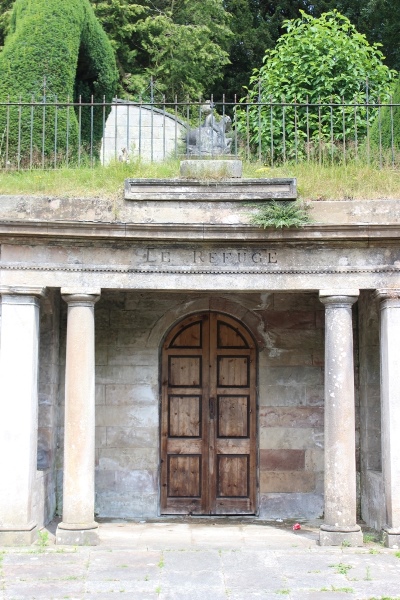 After this lengthy return journey, we find ourselves on the tier directly below the Yew Walk and the grand Conservatories. Here we can observe an area built into the retaining terrace wall between the two tiers, named ‘Le Refuge’. The doorway built into the underside of the lawns remains locked to this day, but has served many purposes in days gone by.
After this lengthy return journey, we find ourselves on the tier directly below the Yew Walk and the grand Conservatories. Here we can observe an area built into the retaining terrace wall between the two tiers, named ‘Le Refuge’. The doorway built into the underside of the lawns remains locked to this day, but has served many purposes in days gone by.
It is this very area in the Gardens that the 15th Earl would relax and enjoy refreshments, occasionally joined by a blind Welsh harpist whom had been employed to fill the Gardens with exuberant music. More commonly however, the doorway opened into a set of dated changing rooms, permitting visitors to change into appropriate swimwear for what lay directly in front of Le Refuge.
This Grade II listed pool space served as the ‘Roman Bath’, complete with a small water statue made from a type of stone named ‘Coade’. This unusual water feature dates back to 1819, bearing resemblance to a merboy.
Colonade of the Muses
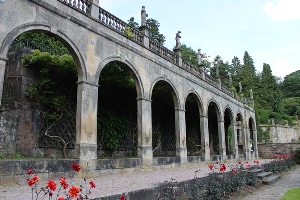 Taking a small stairway down from the area, we can pass underneath a series of shaded archways known as the ‘Colonade of the Muses’. This single-storey loggia consists of nine bays, and joins the plethora of other Grade II listed structures scattered throughout the Gardens.
Taking a small stairway down from the area, we can pass underneath a series of shaded archways known as the ‘Colonade of the Muses’. This single-storey loggia consists of nine bays, and joins the plethora of other Grade II listed structures scattered throughout the Gardens.
Situated on top of the bays are ten statues, nine of which are muses dressed in classical robes. The tenth statue is named Apollo, who originally was not permitted to be stood amongst the nine female statues by the Victorians.
The statues are believed to have originally been located in the conservatory area of the Towers ruins, before being relocated to the Gardens in 1820. Each muse has its own name, whilst representing a specific disciplinary, from West to East:
- Melpomene: Muse of Tragedy.
- Terpsichore: Muse of Dancing.
- Calliope: Muse of Epic Poetry and Singing.
- Urania: Muse of Astronomy.
- Clio: Muse of History.
- Apollo: Protector of Valleys and Grovs, Flocks and Herds, Disperser of Evil, Purifier of Guilt, Patron of the Arts,
- Polyhymnia: Muse of Hymns and Pantomime.
- Euterpe: Muse of Lyrical Poetry.
- Erato: Muse of Love Poetry.
- Thalia: Muse of Comedy.
Each muse stands at 90cm tall, and is entirely out of sandstone. Apollo is the only statue to be made from marble and stands on a unique stone plinth, whereas the surrounding muse statues also have their plinths made from sandstone. In the 1950’s, the muses were scattered throughout various locations in the Gardens and come the 90’s they had fallen into serious disrepair. Thankfully all of them were gracefully restored and replaced atop the colonnade by Cliveden Conservation. The statue of Apollo was separately carved by Conrad Linley-Thompson.
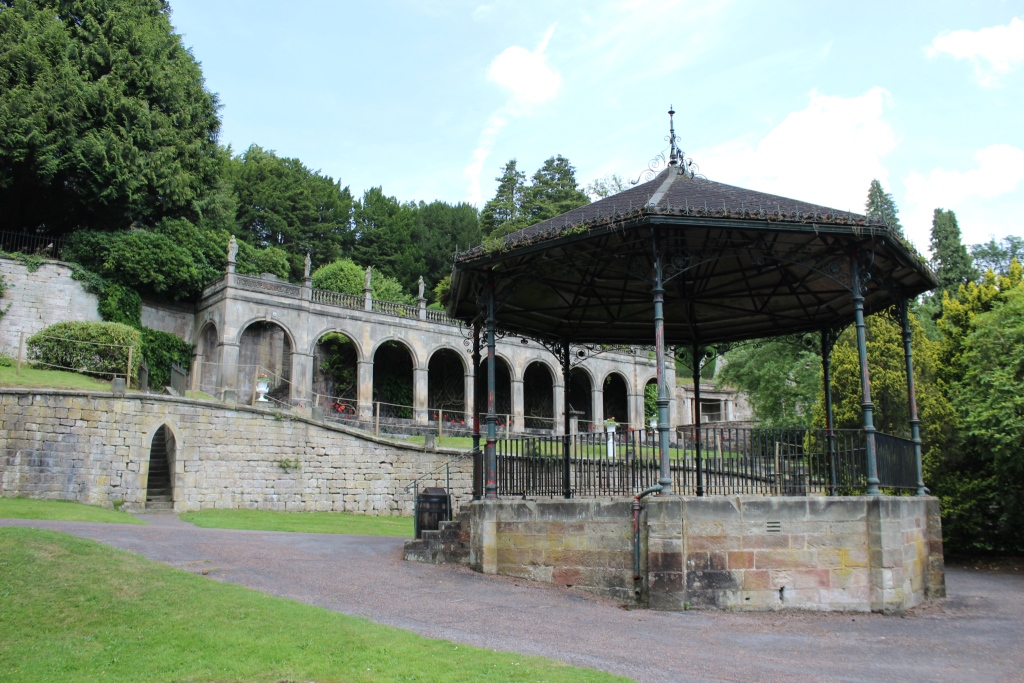
Le Refuge, Colonade of the Muses and the Bandstand.
The Bandstand
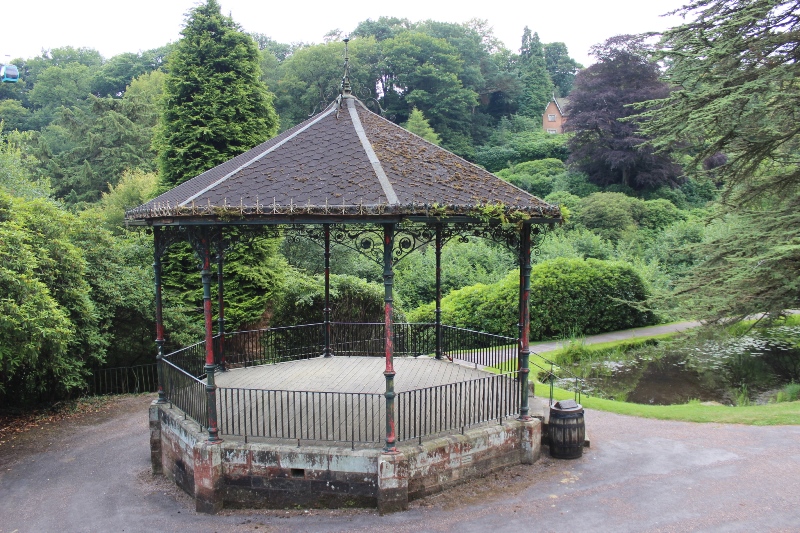 Descending down from a beautifully carved narrow stairway, we encounter the Garden’s very own resident bandstand. This simple yet beautiful structure was first erected when paying guests began to explore the Gardens, and naturally it was put to good use.
Descending down from a beautifully carved narrow stairway, we encounter the Garden’s very own resident bandstand. This simple yet beautiful structure was first erected when paying guests began to explore the Gardens, and naturally it was put to good use.
With original music being a prominent element to the Gardens, having been part of the Earl’s original vision, live bands performed on the stage for almost 100 years right up into the 90’s. Whilst the stage has been unoccupied for a saddening lengthy amount of time now, the structure remains mostly intact and appears intent on doing so for a further admirable time period.
The Canal
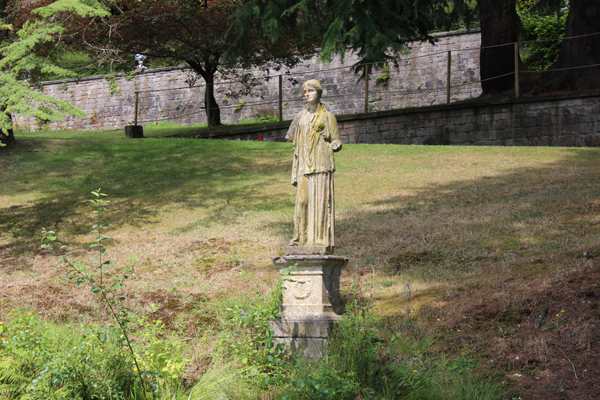 Directly south of the bandstand we can now follow a path directly alongside a body of water known as the Canal. Originating from the Rock Garden, this length of water terminates near the bandstand, and can appear quite contradictory to its name as its actual length isn’t nearly as long as you’d expect. Each side of its banks are occupied by various forms of statuary, which have long since succumbed to nature’s wrath with a coating of moss.
Directly south of the bandstand we can now follow a path directly alongside a body of water known as the Canal. Originating from the Rock Garden, this length of water terminates near the bandstand, and can appear quite contradictory to its name as its actual length isn’t nearly as long as you’d expect. Each side of its banks are occupied by various forms of statuary, which have long since succumbed to nature’s wrath with a coating of moss.
The Rock Garden
As we continue to the West, you can see the Canal slowly becoming swamped by lilly pads and reeds, growing denser until we arrive here at the bottom of the Rock Garden. This is marked by a charming cast iron ornamental bridge that will allow us to cross back over to the North side of the Gardens. It’s fair to say the bridge has seen better days, but yet it refuses to truly submit its alluring and charming appearance to nature.
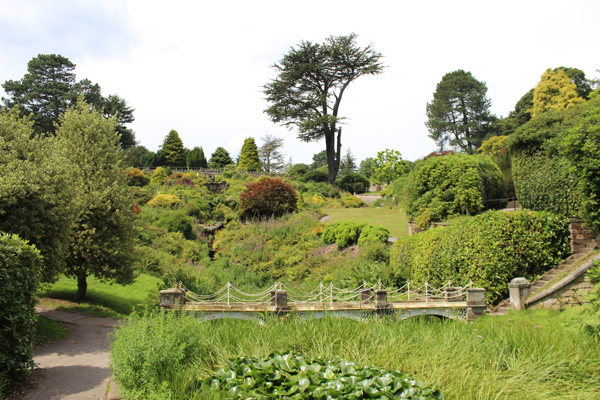
The bottom of the Rock Garden, with the cast iron bridge sturdily standing over the Canal.
Upon crossing the bridge we shall climb a staircase back up the North side of the Gardens, proceeding to make our way North West. As we climb, the entire area to our left, with the cascading waterfall down the centre, is the main area of the Rock Garden; an exquisite clash of plants, sturdy rock work and a truly gorgeous waterfall. This is fed by the main boating lake outside the Gardens, and forms the body of the proceeding Canal, before being used in the Pagoda Fountain at the opposite side of the valley.
In order to cross the torrent of water spewing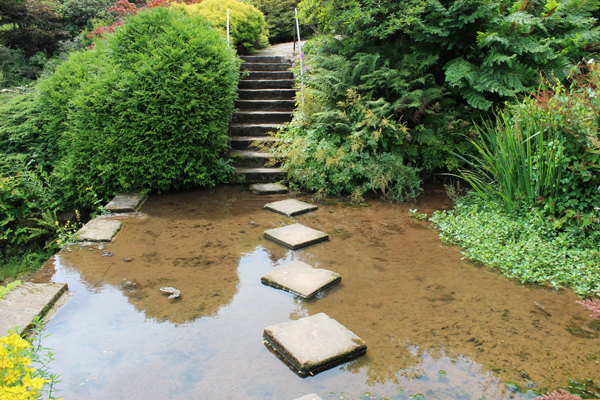 down the valley, there are a series of study stepping stones that lead to the other side. Despite their basic appearance; their uneven placement and surrounding location still makes this part of the Rock Garden seem fresh out of a fairy tale, and stopping on the middle stone provides you with an unbelievably stunning view across the entire valley, allowing you to observe the prodigious scope of the picturesque Gardens almost in full. Be careful though, they can be slippery and there is a slightly unnerving drop on the other side!
down the valley, there are a series of study stepping stones that lead to the other side. Despite their basic appearance; their uneven placement and surrounding location still makes this part of the Rock Garden seem fresh out of a fairy tale, and stopping on the middle stone provides you with an unbelievably stunning view across the entire valley, allowing you to observe the prodigious scope of the picturesque Gardens almost in full. Be careful though, they can be slippery and there is a slightly unnerving drop on the other side!
A collision of colour; viewed from the Rock Garden stepping stones.
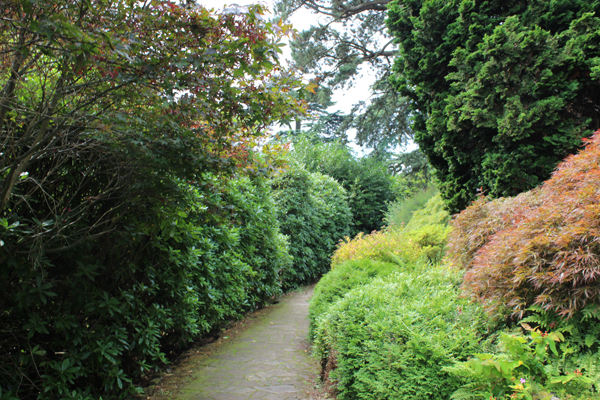 After crossing the Rock Garden, we can now continue to the Southern side of the Gardens. This side of the Gardens severely lacks the amount of prominent features, architectural structures and stunning ornaments the grace the Northern area, but that’s not to say there are no points of interest. On a scorching hot summer’s day (arguably one of the most ideal times to explore the Gardens), the Northern side offers a gigantic increase in size, with dominating trees and shrubbery, providing constant shade whilst still allowing you to make progress as you trek around.
After crossing the Rock Garden, we can now continue to the Southern side of the Gardens. This side of the Gardens severely lacks the amount of prominent features, architectural structures and stunning ornaments the grace the Northern area, but that’s not to say there are no points of interest. On a scorching hot summer’s day (arguably one of the most ideal times to explore the Gardens), the Northern side offers a gigantic increase in size, with dominating trees and shrubbery, providing constant shade whilst still allowing you to make progress as you trek around.
Swiss Cottage
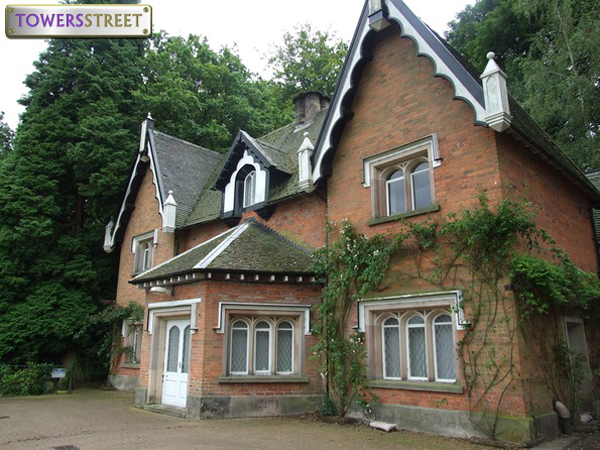 Following the path all the way around the Northern side of the Gardens leads us to the Swiss Cottage. This lone structure is the only standout visible element to the Northern area of the Gardens that’s visible from the South; almost as if it breaking through the surface of trees that huddle around it, gasping for air. The Cottage was built in 1835 by Thomas Fradgley, and retains a Grade II status to this day. It has served a huge range of purposes over the years, and has been incorporated into the modern running of the theme park, with the Altonville Motel dining experience occurring on its patio during Scarefest 2014.
Following the path all the way around the Northern side of the Gardens leads us to the Swiss Cottage. This lone structure is the only standout visible element to the Northern area of the Gardens that’s visible from the South; almost as if it breaking through the surface of trees that huddle around it, gasping for air. The Cottage was built in 1835 by Thomas Fradgley, and retains a Grade II status to this day. It has served a huge range of purposes over the years, and has been incorporated into the modern running of the theme park, with the Altonville Motel dining experience occurring on its patio during Scarefest 2014.
The cottage was constructed at the order of the Earl in order to house the blind harpist whilst he composed music to contribute to the elysian ambience of the Gardens. Since then, the cottage has been the location of a fine dining restaurant (inside and out), before being exclusively used for behind the scenes reasons. Access is therefore no longer permitted inside the lodge, but that won’t prevent us from having a sneak peek through the windows!
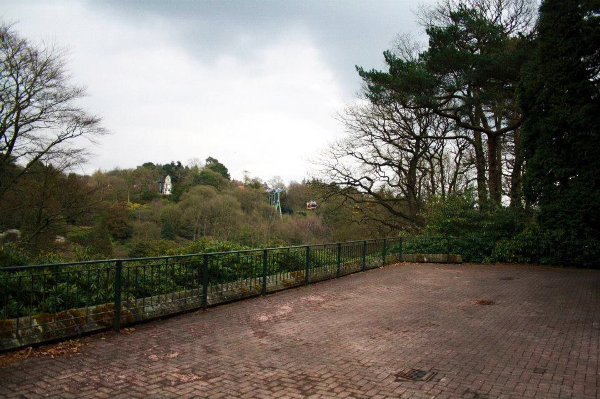 One aspect which would be criminal to overlook from the Swiss Cottage is the staggering views over the entire Northern side of the Gardens. Virtually every element covered on our tour is visible, from the Chroagic Monument all the way over to the Gothic Prospect Tower, and the tiny yet colourful complimenting Skyride gondolas gently drifting over the top of the Pagoda Fountain. The open space of the patio area allows plenty of angles to view the Gardens from, and it is with this view that we shall conclude our tour of the breathtakingly beautiful Alton Towers Gardens.
One aspect which would be criminal to overlook from the Swiss Cottage is the staggering views over the entire Northern side of the Gardens. Virtually every element covered on our tour is visible, from the Chroagic Monument all the way over to the Gothic Prospect Tower, and the tiny yet colourful complimenting Skyride gondolas gently drifting over the top of the Pagoda Fountain. The open space of the patio area allows plenty of angles to view the Gardens from, and it is with this view that we shall conclude our tour of the breathtakingly beautiful Alton Towers Gardens.
Whether you’re a frequent theme park visitor who has frequently overlooked the Gardens in order to grab the next quick adrenalin kick, or someone who prefers to visit the park on a leisurely basis, I hope this virtual tour has been an insightful experience and has encouraged you to take a fraction of your day visiting the Resort to explore this vast opportunity for unsurpassed tranquillity and escapism.
Route Map
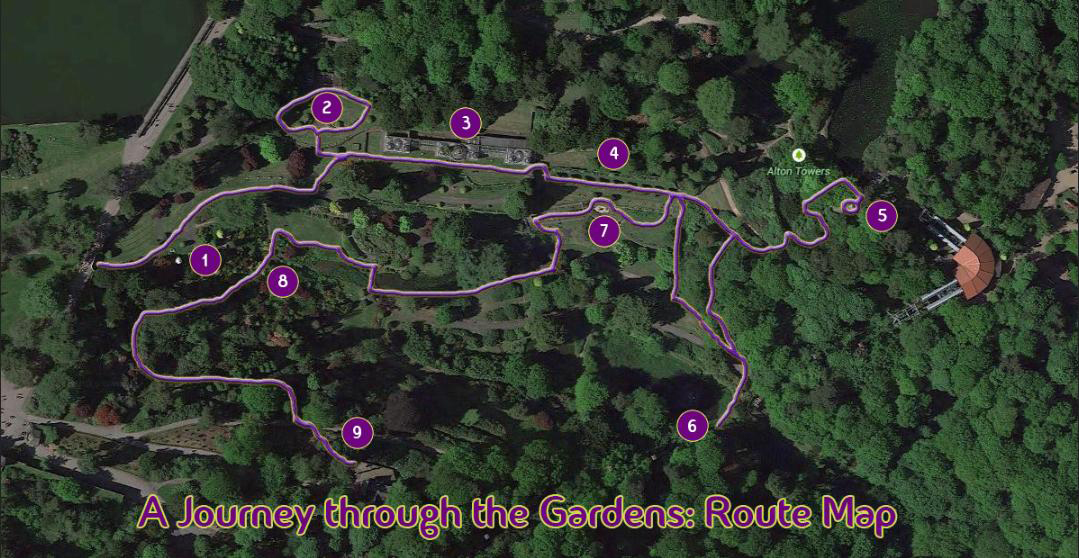
1: Chroagic Monument.
2: Dutch Garden.
3: The Conservatories.
4: Yew Walk.
5: Gothic Prospect Tower.
6: Pagoda Fountain
7: Le Refuge & Roman Bath
8: Rock Garden Stepping Stones
9: Swiss Cottage
Danny and TowersStreet would like to thank the following contributors for their images and research documents which have featured in this article:

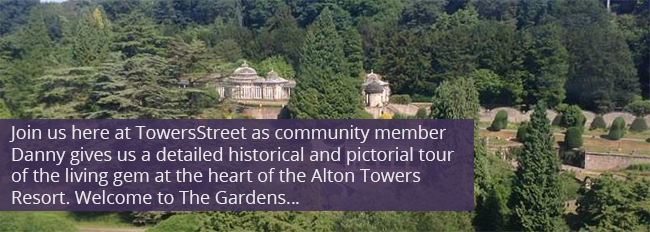
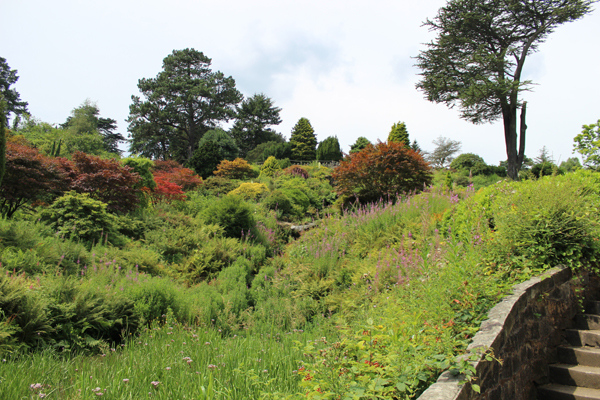
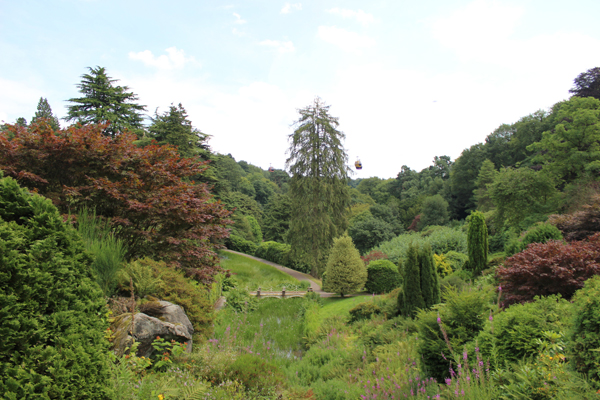
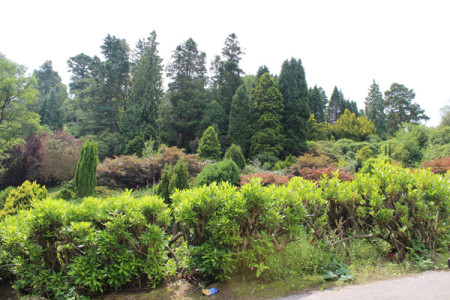
 On my first visit to Alton Towers back in 2000, even the dizzying heights from atop Squirrel Nutty were enough to terrify me. Fast forward to the age of twenty and I've conquered every ride and attraction at the Resort that little Danny would have never dared step foot on.
On my first visit to Alton Towers back in 2000, even the dizzying heights from atop Squirrel Nutty were enough to terrify me. Fast forward to the age of twenty and I've conquered every ride and attraction at the Resort that little Danny would have never dared step foot on.